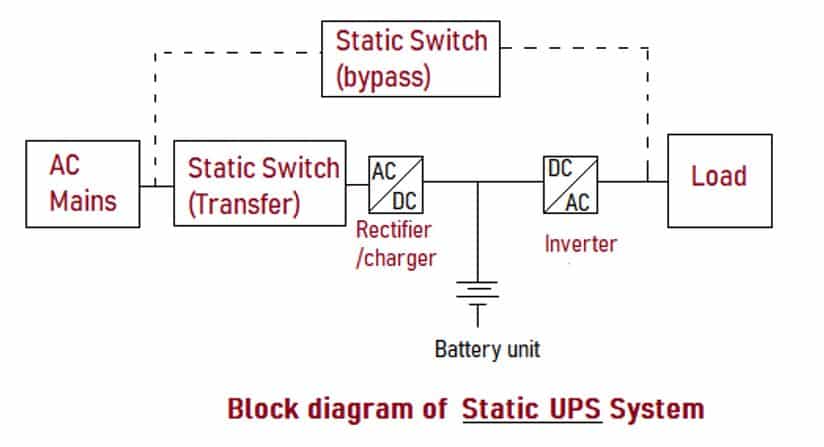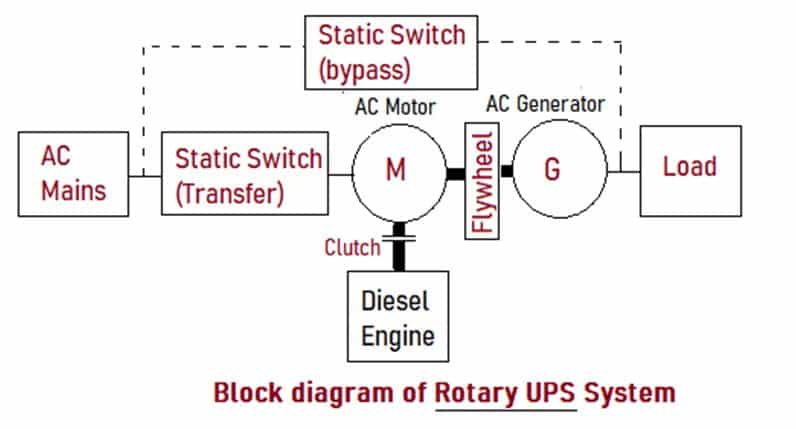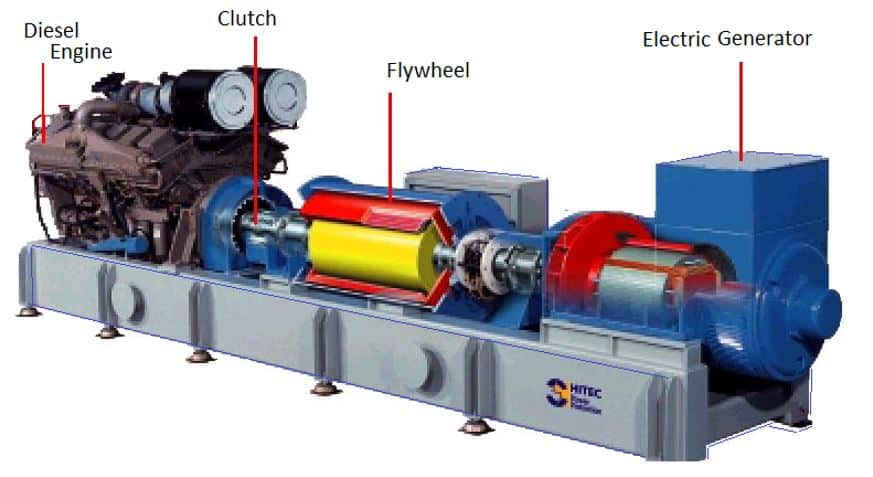Static UPS and Rotary UPS systems are uninterrupted power supplies. They both fulfilling the same functions, however provide different performances. They also have different characteristics & constructional elements.
The choice of the UPS depends on the following.
- Power requirement
- Investment capacity
- Type of design
Purpose of UPS
We use a UPS system for those applications where the critical loads need continuous power. The UPS does a smooth changeover in the event of severe voltage dips & power outages.
There are two types of UPS.
- Static UPS and
- Rotary UPS
UPS Components
Electronic UPS systems typically include a battery, charger, inverter (a device that converts direct current to alternating current), and an automatic transfer switch. The automatic switching changes the power source from the primary source to the inverter when the primary power source fails. Thus, the power is always available to the load.
UPS sizes
The charge storing capacity of the battery is very important for UPS sizing. The size of the UPS depends on the power backup capacity of the battery & UPS rating. For delivering more power for a longer duration, the UPS & battery size is big.
On the other hand, for delivering less power for a shorter duration, the UPS & battery size is small.
Most of the UPS systems work in a standby mode. The inverter keeps the batteries fully charged by the primary power source. Thus, the inverter remains in ready condition.
Static UPS System

Static UPS does not have any rotary parts (except cooling fans). The static UPS system has batteries and an inverter. UPS converts DC voltage into AC voltage. The below diagram shows how the static UPS converts DC voltage into AC voltage.

The rectifier unit of the UPS converts the primary source AC into DC to charge the batteries. Further, the Inverter circuit converts battery DC voltage to AC voltage to supply the load. When the power supply is available, the rectifier unit charges the batteries & the power supply to the load is available through a static switch.
When power fails, the static switch transfers the load on the inverter and now the inverter supplies power to the load. The inverter takes the DC power from the batteries and converts it to AC voltage.
The inverter transfers the load to a static switch after the restoration of the primary power source. And, thus the batteries start charging again through the primary power source.
Rotary UPS System
The below figure shows the block diagram of rotary UPS.

A Rotary UPS system has rotating parts such as a motor, generator, and transfer switch. There was the widespread application of this UPS for supplying power to critical equipment and lighting. The rotary UPS does not have batteries. It has a flywheel.
A flywheel-driven rotary UPS is most suitable for applications that require ride-through for short duration power loss & voltage dips. However, the support times or backup time of rotary UPS is usually in the order of a few seconds to a few minutes.
The motor-generator set is the best option for getting more support or backup time.

The electricity generation by the turning of the flywheel supplies the power to load for its rated backup time. Thus, the stored mechanical energy in the flywheel allows the M-G set to deliver its full-rated output for a minimum of 200 milliseconds.
UPS Installation
Static UPS systems are compact and require less space. Therefore, we can install it inside a building. Whereas the majority of Rotary UPS systems installations are in an open environment, only in a few instances within a specially built enclosure.
Basic Difference between Static and Rotary UPS
Static UPS system functions on the semiconductor power electronics. Electronic devices have very less switching time. Therefore, the Static UPSs can provide uninterrupted power without any transfer delay because the inverter has its connection with batteries.
Static UPS systems directly connect the power supply to the load in normal operation and charge the battery through the rectifier. The transfer switch connects the inverter to the load to supply AC power from the DC power converted to the battery when there is a blackout.
Rotary UPS systems are suitable for delivering power to load for a shorter duration during momentary interruption and voltage dips. Unlike static UPS, it has rotary parts.
Merits of Rotary UPS Systems
- They are more energy-efficient.
- Efficiency in the range of 95-97%. although more expensive.
- Rotary UPS systems are less likely to fail.
- They are available in higher capacities and the possibility of generating higher voltages (with power ranges from 200kW to 3000kW).
- By installing equipment in parallel, the Rotary systems can reach up to 40MW.
- In rotary UPS, we can replace the batteries by a kinetic storage system, and they have an electric motor/generator that transforms electrical energy into mechanical energy and vice versa.
- During their operation, the stored energy of rotary UPSs supply power to load in the event of a failure or outage, although to protect ourselves against power outages we must have a coupled diesel or gas engine.
Demerits of Rotary UPS Systems
- They suppose a higher cost, use of space (for low autonomies)
- Static UPS systems generate noise.
- They are more expensive.
- They need auxiliary elements such as climate motors, pumps, ventilation grilles, etc.
Merits of Static UPS Systems
- Static UPSs have their widespread application.
- There is a possibility of expansion according to our needs
- Static UPS systems require a lower initial investment.
- Can expand the UPS system in a modular way, even working in parallel.
- Operating cost studies show that rotating UPS systems are cheaper to maintain.
Drawbacks of Static UPS
- The static UPSs have a large number of elements. therefore its failure chances are more.
- In turn, they also need auxiliary elements: Climate, cleaning, batteries.
- They cope less with short-circuit intensity than the dynamic ones.
- They need to have air conditioning systems since their ideal working temperature ranges between 20° C -25 ° C.
Applications
Nowadays Uninterrupted power supply (UPS) systems are installed in almost all critical areas. Bank, financial services, security, Hospitals and medical equipment, Network systems, Telecommunications, Air traffic, defense, insurance are very few to mention.